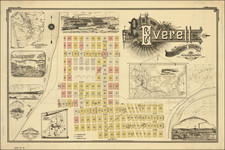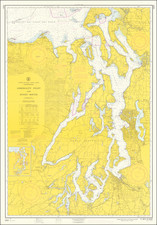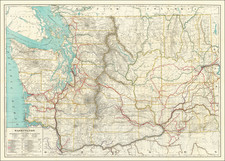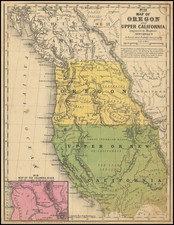Gold Mining on Money Creek -- 40 Miles East of Seattle
Rare blue printed map of the mining regions of the Gold Mountain Mining Company in the Money Creek District of King County, approximately 40 miles east of Seattle.
The map was drawn by a young Oliver P. Anderson, who would go on to become of the most influential Washington mapmakers, and published her by the Kroll Map Company, who has added their label to the map.
The map shows the area between Skykomish and Lake Elizabeth, centered on Temple Mountain and Money Creek. The tracks of the Seattle & Montana Railway are shown, as is a saw mill and proposed bunkers.
The following report about Money Creek appeared in Mining in the Pacific Northwest by L. K. Hodges published by Seattle Post-Intelligencer in 1897,
...The Gold Mountain Mining Company’s property consists of eight full sized claims, namely: Grand Central, Bonanza Queen, Paymaster, Crown Point, San Francisco, Red Jacket, Bald Eagle and Happy-Go-Lucky.
All these claims are situated on Money Creek, King County, Washington, within about three miles of the Great Northern Railroad and only fifty-two miles by rail from a smelter. They have large bodies of iron and copper sulphide ore carrying gold, which can be made to pay dividends by a small expenditure for development. Regarding Money Creek the Washington Mining Journal says:
“This district is in the western slope of the Cascade Mountains, in King County, State of Washington, and is easily accessible. Skykomish, on the Great Northern Railway, is the nearest railway station. If there were no other mines in the State of Washington it could still claim distinction as a mining state on the strength of Money Creek alone. The large disclosures of ore in the locality exceed those of Treadwell, in Alaska. The bodies of ore on the Bonanza Queen and Paymaster are believed to be inexhaustible. The Gold Mountain Mining Company is the owner of both claims, and with its new and complete equipment of machinery and a force of competent workmen will record a large output during the present
year."A limited amount of treasury stock for sale.
Write for prospectus and price of stock.
The reality of the Money Creek finds was vastly overstated. Of the eight “full-sized claims” mentioned above, not one produced enough to be listed among more than 1,000 mines in The Gold Seekers… A 200 Year History of Mining in Washington, Idaho, Montana, and Lower British Columbia, by Pauline Battien in 1989.
Various mining operations continued along Miller River and Money Creek, a few maybe even made money, but overall like elsewhere in Skykomish Valley, far more money got poured into the ground than was ever recovered as return on investment.
Blueprint maps
Blueprint maps were among the most popular means for the swift printing of maps for which there would be a limited demand. A blueprint map could be made and/or revised much more quickly than a lithograph, cerograph, or other printing method, and at a much lower cost.
Blueprinting as a method was invented in 1842 by John Herschel, a chemist, astronomer, and photographer. A cyanotype process, one starts by drawing on semi-transparent paper, weighted down by a top sheet of paper. The paper would be coated with a photosensitive chemical mixture of potassium ferricyanogen and ferric ammonium citrate. The paper would then be exposed to light, wherein the exposed portions turned blue and the drawn lines, protected from exposure, would remain white.
The blueprint process was an improvement on the expensive and time-consuming method of hand-tracing original documents. The technique was particularly popular with architects; by the 1890s, a blueprint was one-tenth the cost of a hand-traced reproduction. It could also be copied more quickly.
Blueprint maps began to appear as early as the 1850s and 1860s, but they really began to become the standard for mining and similar limited-purpose maps by the 1880s. The ability to create these maps quickly and at a low cost made them the standard for short-run prints, ideal for mapping mining regions in the West and for similar purposes.
The method still exists today, but in a very limited fashion. In the 1940s, diazo prints (whiteprints or bluelines) became more popular, as they were easier to read and faster to make. The blue lines on a white background of these prints are now what most people call blueprints.
Rarity
The map is apparently unique.
We note that the Forrest P. Johanson Collection of Pacific Northwest Mining Maps, 1890-1969, at the University of Washington, includes 2 undated maps with different titles relating to The Gold Mountain Mining Co and Money Creek.
Oliver Phelps (O.P. Anderson) is one of Seattle's first indigenous map publishing companies. Anderson was an amateur photographer and owner of a photographic supplies business in Seattle in the early 1900s. Anderson first worked as a bookkeeper in Seattle in the early 1880s, though by the end of that decade he was doing business as a draughtsman.
The earliest maps bearing Anderson's name appear in about 1885, including the name "Anderson Brothers." Most of these early maps are blue print maps, a style of mapmaking which was becoming more common in the 1880s with publishers looking to produce fast inexpensive maps that were quickly and easily updateable. This form of map was very popular in the west, where the rapid growth of communities, train lines and mining regions were especially robust. The first map jointly issued by Anderson and Whitworth & Thomson was West Seattle five acre tracts . . ., blue print map of a hand drawn plat map from the records of Kings County, circa 1885.
Anderson formed his civil engineering and map publishing business, O.P. Anderson & Co., in the early 1890s, with the business changing its name to the O.P. Anderson Map & Blue Print Co. by the mid 1890s. Beginning around 1900, Anderson began selling photographic supplies as president of Anderson Supply Co., located at 111 Cherry Street in Seattle.
Around 1913, Anderson's son, Maurice P. Anderson, took over as president of the company, and Anderson acted as secretary-manager, a position he continued to hold until around 1940, probably until his death. Anderson Supply Co. continued to do business, with Maurice Anderson as president, until the late 1950s.













![[Map of the United States, illustrating the routes of the Canadian Pacific Railway and the Seattle, Lake Shore and Eastern Railway]](https://storage.googleapis.com/raremaps/img/small/71080.jpg)
![[Oregon Territory] Carte de l'Oregon (and) [Astoria Factory]](https://storage.googleapis.com/raremaps/img/small/77722.jpg)